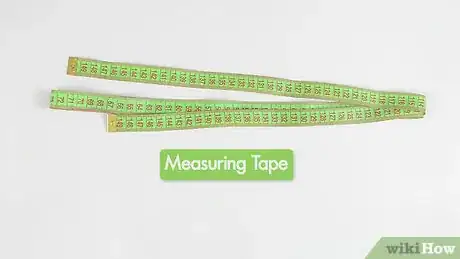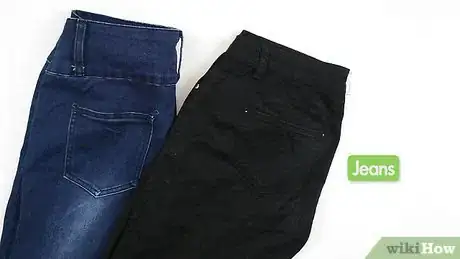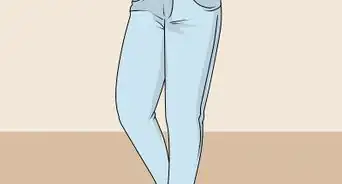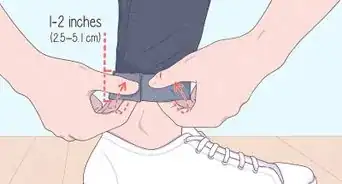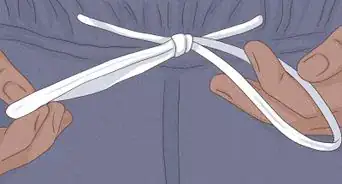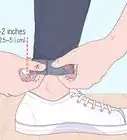This article was co-authored by Chloée Ohayon-Crosby. Chloée Ohayon-Crosby is a Costume Designer and Wardrobe Specialist in Los Angeles, California. With over eight years of experience in fashion consulting, Chloée specializes in personal, film, theater, and commercial styling as well as image consulting and costume design. Chloée has worked as an assistant designer for the distinguished fashion house Chloée and as a freelance stylist with Glamour Italia. Chloée studied Fine/Studio Arts at the Ecole Nationale Supérieure des Beaux-Arts and Fashion Design and Merchandising at the world renowned ESMOD École Supérieure des Arts in Paris, France.
wikiHow marks an article as reader-approved once it receives enough positive feedback. In this case, 85% of readers who voted found the article helpful, earning it our reader-approved status.
This article has been viewed 546,663 times.
Measuring your pants involves finding the length of the waist, inseam, and hips, as well as other fit specifications on occasion. When getting the measurements, you should use your favorite pair of pants so that you get the best numbers possible. Determining your pant size makes it easier to buy pants that fit well because you won't have to rely on size conversions or estimations between brands. Once you know your pant size and what to look for in a pair, shopping for jeans or other pants that fit perfectly will be a breeze!
Steps
Getting the Measuring Basics Down
-
1Use a measuring tape. Tailors, seamstresses, clothiers, and other garment makers generally use tape measures to get the correct measurements of a person when fitting for clothes or altering items. These portable, flexible tools are your best friend when it comes to measuring your pants.
- When measuring with a tape measure, pull the tape taut, but don't stretch it. Clothing tape measures are often made of a soft synthetic material that can distort if stretched, resulting in inaccurate measurements.
- You can also use a plastic measuring tape that you might find in your toolkit. This type of tape measure isn’t as easy to use, but it will still bend, allowing you to measure curves.
-
2Use a pair of pants that fit you well. If you’re measuring your pants to figure out which style and size is right for you, it’s best to use a pair of pants that fit you properly. Ideally these pants will not be too worn out or stretched. The legs of the pants should also extend roughly to your ankle bone, or a little lower depending on preference.
- Not all types of pants will have the same measurements. Grab a few different kinds of pants that fit you well. Dress pants will be slightly different than chinos, or jeans.
Advertisement -
3Lay your pants flat on the floor. The easiest way to measure pants is to lay the pants on a flat surface. If you try to measure a pair of pants that you are wearing, you may not get the right measurements as you shift your body to see the measurements.
- Your pants shouldn’t be too worn in so that you can get a realistic measurement.
- If the pants you are measuring are wrinkled, quickly smooth the fabric out with an iron.
- Measuring your pants is mostly the same for both men and women. However, sizing for men is typically represented by the length of the measurement in inches, whereas women’s sizes are typically represented by another number[1] .
Measuring Your Pants
-
1Measure the waist of your pants.[2] To get the most accurate measurement of your pant’s waist lay the pants flat on the floor. Smooth the pants out so there is no bunching. Don’t stretch the pants, though. Measure flat across the back waistband from one corner to the other. Double the number to get the actual waist size.[3]
- Make sure your pants are also facing up, with the front pockets facing the ceiling.
- If your pants are lying correctly, the front part of the waistband will be resting slightly below the back.
-
2Measure your actual waist. You may want to measure your actual waist, but also the waist of your pants to get an accurate size. To measure your waist, wear underwear or similar clothing that is well fitting. Make your measurement at your natural waist. This is at the thinnest portion of your body, between your ribs and your belly button. You can find your natural waist by bending to the side and seeing where your body creases. Wrap the measuring tape around your waist and record the measurement where the tape meets itself. Look at your measurement without bending. Use a mirror to help you.[4]
- Keep one finger between the tape and your body as you measure. This keeps you from drawing the tape too tightly.
- Resist the urge to draw your stomach in. Try to stand as you normally would, while still having proper posture.
- Keep the measuring tape parallel to the floor for an accurate measurement.
- If you are having a hard time finding where your waist is, wrap your hands around your stomach and squeeze slightly. Then, move your hands down until you feel the top of your hip bone.
- By measuring your waist and the waist of your pants separately, you can learn what your actual waist size is, and the actual size of your pant’s waistline as the two might be slightly different.
-
3Measure the hips. Measure across your pants at the base of the zipper. Make sure that you go to the edge of each seam. Once you’ve measured the front, double the number to get the whole measurement.
- When measuring your pants on the floor, make sure to measure from the outer stitching of each seam.
-
4Measure your inseam.[5] Starting from the crotch, where the pieces of fabric in your pants intersect, draw the measuring tape down the inside of one leg and to the very bottom of the pant leg where it would naturally hang around your shoe. You can also wear a pair of pants and stand straight with your back against the wall to get another measurement for accuracy. However, this method works best if you have a friend to measure for you.[6]
- Note that inseams are usually measured to the nearest half-inch.
- Use a pair of pants that fit you well to get the most accurate measurement on your inseam.
- If you are measuring alone, tape the measuring tape to the inside of your heel, or the bottom of your pants (whichever you prefer) and then measure upwards.
- If the leg of your pants doesn't sit where you'd like it to (if you cuff your pants), measure to where you'd like your pair of pants to end.
-
5Measure your front rise. To measure the front rise of your pants, start at the bottom center of the crotch seam and measure up to the top of the waistband. Rises usually range from 7 inches (180 mm) to 12 inches (300 mm).[7]
- Pants typically come in a regular rise, low rise, and high rise. Low sits below the waist, regular at the waist, and high above the waist.
- Note that the definition of the rise measurement varies. Some define the "rise" as the measurement extending from the back of the waistband down between the legs and up to the front of the waistband.
Expert Q&A
-
QuestionDo I need all of these measurements when buying pants?
 Chloée Ohayon-CrosbyChloée Ohayon-Crosby is a Costume Designer and Wardrobe Specialist in Los Angeles, California. With over eight years of experience in fashion consulting, Chloée specializes in personal, film, theater, and commercial styling as well as image consulting and costume design. Chloée has worked as an assistant designer for the distinguished fashion house Chloée and as a freelance stylist with Glamour Italia. Chloée studied Fine/Studio Arts at the Ecole Nationale Supérieure des Beaux-Arts and Fashion Design and Merchandising at the world renowned ESMOD École Supérieure des Arts in Paris, France.
Chloée Ohayon-CrosbyChloée Ohayon-Crosby is a Costume Designer and Wardrobe Specialist in Los Angeles, California. With over eight years of experience in fashion consulting, Chloée specializes in personal, film, theater, and commercial styling as well as image consulting and costume design. Chloée has worked as an assistant designer for the distinguished fashion house Chloée and as a freelance stylist with Glamour Italia. Chloée studied Fine/Studio Arts at the Ecole Nationale Supérieure des Beaux-Arts and Fashion Design and Merchandising at the world renowned ESMOD École Supérieure des Arts in Paris, France.
Costume Designer & Wardrobe Specialist Utilizing all the different pants measurements will help you get a great fit, but inseam and waist size are really the most important.
Utilizing all the different pants measurements will help you get a great fit, but inseam and waist size are really the most important. -
QuestionWhy do you measure men's pants on the outside seam?
 Community AnswerThe crotch seam can be higher or lower depending on the cut of the pants, so you always measure the outside seam because that's more accurate.
Community AnswerThe crotch seam can be higher or lower depending on the cut of the pants, so you always measure the outside seam because that's more accurate. -
QuestionHow do I measure the width of the bottom of my pants?
 Community AnswerLay the pant down flat, making sure it is creasing at the side seam or inseam. Then measure the hem of the jean and multiply by two (that's the front and the back together). This will be the measurement of the leg opening.
Community AnswerLay the pant down flat, making sure it is creasing at the side seam or inseam. Then measure the hem of the jean and multiply by two (that's the front and the back together). This will be the measurement of the leg opening.
wikiHow Video: How to Measure Your Pants
References
- ↑ http://www.womenssizechart.com/
- ↑ Chloée Ohayon-Crosby. Costume Designer & Wardrobe Specialist. Expert Interview. 24 July 2020.
- ↑ http://www.ebay.com/gds/Proper-Guidelines-How-to-Measure-Jeans-Pants-/10000000178623897/g.html
- ↑ http://www.webmd.com/diet/waist-measurement
- ↑ Chloée Ohayon-Crosby. Costume Designer & Wardrobe Specialist. Expert Interview. 24 July 2020.
- ↑ http://www.ebay.com/gds/How-to-Measure-Your-Inseam-/10000000178626635/g.html
- ↑ http://www.primermagazine.com/2013/spend/pants-rise-explained-and-why-low-rise-isnt-always-your-best-choice
About This Article
To measure your pants, start by laying them flat on the floor and smoothing out any lumps or wrinkles with your hands. Then, use a measuring tape to measure from 1 side of the waistband to the other. Double that number to get the waist size of the pants. Next, find the inseam by measuring from the crotch of the pants to the very bottom of 1 of the pant legs. You can also measure the hip size of your pants by measuring the distance between the left edge of the pants and the right edge at the base of the zipper. Then, double that number. If you want to learn how to measure your waist while you're wearing your pants, keep reading!
